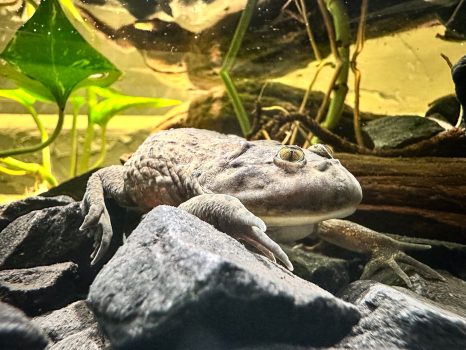Budgett’s Frog
Common Name: Budgett’s Frog
Scientific Name: Lepidobatrachus laevis
Names: N/A
Locations: Whitby, Vaughan & London

Diet
Budgett’s Frogs are carnivorous amphibians, primarily feeding on a diet consisting of insects, small vertebrates, and occasionally other frogs.
Average lifespan
In captivity, Budgett’s Frogs typically live around 10 to 15 years, though their lifespan in the wild is not well-documented.
Size
Budgett’s Frogs are relatively large frogs, with adults reaching lengths of up to 10 to 15 centimeters (4 to 6 inches) in length.
Weight
Adult Budgett’s Frogs can weigh anywhere from 100 to 200 grams (3.5 to 7 ounces), with females generally being larger and heavier than males.
About
Budgett’s Frogs are native to South America, particularly found in countries such as Argentina, Bolivia, and Paraguay. They inhabit various freshwater habitats including marshes, ponds, and temporary pools, where they can find suitable food and breeding sites.
Size and behavior
Budgett’s Frogs have a distinctive appearance characterized by their flattened bodies, large mouths, and bulging eyes. They are primarily aquatic frogs, spending much of their time submerged in water where they hunt for prey and seek refuge from predators. Despite their intimidating appearance, they are generally shy and reclusive animals, preferring to avoid confrontations with larger predators.
Diet and nutrition
Budgett’s Frogs are opportunistic feeders and will consume almost anything that fits into their mouths. In captivity, they can be fed a diet of live or frozen feeder insects such as crickets, mealworms, and roaches, as well as small vertebrates such as feeder fish or pinkie mice. Providing a varied diet ensures that they receive the necessary nutrients for growth, development, and overall health.
Conservation status
The conservation status of Budgett’s Frogs in the wild is currently of least concern. While they may face localized threats from habitat loss, pollution, and collection for the pet trade in some areas, they are still relatively abundant and widespread throughout their range. However, like many amphibian species, they may be impacted by habitat destruction, climate change, and disease.
Fun fact
Budgett’s Frogs are known for their unique defensive behavior. When threatened, they will inflate their bodies and emit a loud, low-pitched vocalization that sounds like a “honking” noise, which serves as a warning to potential predators. Additionally, Budgett’s Frogs have specialized skin glands that produce toxins, which they use as a chemical defense against predators. Despite their fearsome appearance and defensive capabilities, they are generally harmless to humans and are valued as fascinating amphibian species in the pet trade.
Call or visit your local Reptilia Facility to learn how you can adopt one of these amazing reptiles.








